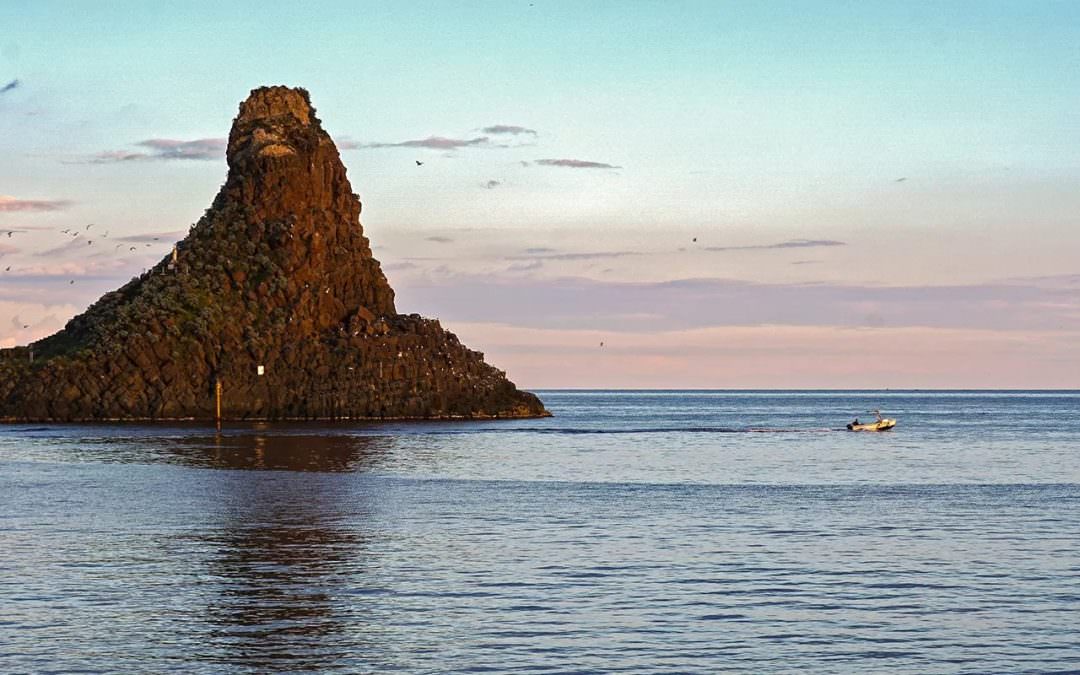Along the Sicilian east coast, at the foot of Europe’s highest active volcano, lies the so-called Cyclops Coast. We are here just a few kilometres north of the city of Catania, which is also called the black daughter of Etna. It got this name after being surrounded by the eruption of 1669 and completely destroyed by the earthquake of 1693 and rebuilt almost entirely in the Baroque style, made of black basalt.
There are several small fishing villages along this coast, such as Aci Trezza and Aci Castello. But why is this eastern coast also called the Cyclops Coast? Who were the Cyclopes and where did they live?
The Legend of Polyphemus
Here we must return to Homer and the legend he describes in the Odyssey, according to which Odysseus finds himself a prisoner in the cave of the cyclops Polyphemus. This giant, with only one eye in the middle of his forehead, lived on Mount Etna and worked in the forge of the fire god Hephaistos, who is also referred to by the Latin name Vulcano. Odysseus only managed to break out of captivity thanks to a ruse. As he fled towards the coast, Polyphemus hurled lava blocks at the hero for having gouged out the Cyclops’ only eye and taunted him.
However, these lava blocks did not hit Ulysses and fell into the sea, just a few hundred metres from the coast, and are now known as the Faraglioni of Aci Trezza.
This is how Homer wrote it down, but the geological explanation is somewhat different.
The geological origin of the Faraglioni of Aci Trezza
About 570,000 years ago, Etna did not exist as such and where the volcano is today was only a large bay, the so-called pre-Aetnensian Gulf. During the activity of the underwater volcanoes, volcanic material came to the sea surface and this led to the formation of lava cushions and basalt columns.
The entire marine area in front of the town of Aci Trezza is now a protected natural area, called “Protected Marine Area of the Island of the Cyclops“. The entire nature reserve of Lachea Island and Faraglioni of Aci Trezza goes from Capo Mulini, in the north, to Aci Castello, in the south.
Aci Castello
The neighbouring town of Aci Castello is known for a 12th century fortress, probably built on the ruins of a pre-existing fortress dating back to Byzantine times and even earlier, to Roman times. It is located on a lava rock about 20 metres high, which is a very interesting geological formation, characterised by lava pillows. Inside the fortress there is a small town museum and a small botanical garden, and without a doubt the climb is rewarded with an incredible view over the coast.
The Legend of Aci
Besides these two villages, several other villages at the foot of Etna bear the name Aci in their denomination (Acireale, Aci Catena, Aci Sant’Antonio, …). So who or what was Aci?
The answer is provided by a legend from Greek mythology.
The real name was Akis, a young shepherd who was in love with the nymph Galathea, but unfortunately there was a rival, the cyclops Polyphemus. Polyphemus knew very well that Galathea did not return his love. That was why he killed Akis with a huge block of lava in the hope that Galathea would turn to him.
But the nymph’s reaction was different than expected. When the nymph learned that the Cyclops had slain her lover, she cried all the tears she had. The gods took pity on her and turned Akis into a river. Thus the nymph could live with her beloved for eternity.
All the villages and towns along the river have adopted the name Akis, which over time has been changed to Aci.
The river now flows underground, having been covered by lava flows due to various eruptions of Mount Etna. Occasionally during heavy rains, somewhere the river comes out of the earth again and for the locals it is Akis that shows itself on the surface of the earth.
